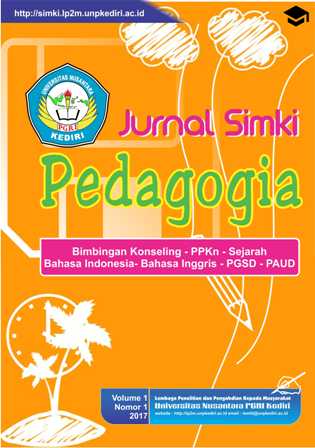IMPLEMENTATION OF AUTHENTIC ASSESSMENT BASED ON 2013 CURRICULUM BY ENGLISH TEACHER IN TEACHING WRITING IN SMAN 1 PAPAR
Author (Penulis)
DEWANTI ANGGARIZAUniversitas Nusantara PGRI Kediri
Author Identity (NPM)
14.1.01.08.0095Abstract
ABSTRACT
This study aims to describe the types of authentic assessment, the implementation of authentic assessment and the strength and weaknesses of the authentic assessment in teaching writing by English teacher in SMAN 1 Papar. The writer uses qualitative approach by using case study to describe the data. To collect the data the writer uses some techniques such as observation checklist, interview, and documentation, and analyzed it using qualitative models of Miles and Huberman. The data then validated with triangulation data. Based on the research result, it can be reported that; (1) the teacher implemented 4 types of authentic assessment in teaching writing they are, portfolio assessment, performance assessment, peer assessment and observation; (2) the teacher applied 4 steps from 6 steps in implementing the authentic assessment; (3) the teacher faces more weaknesses that strengthen in implementing the authentic assessment. Thus the writer suggests to English teacher to practice and spend more time in preparing, and developing the rubric scoring of the authentic assessment before it was brought into the classroom.
Keyword
aReference
REFERENCES
Adnyayanti, N.L.P.E. 2013. Analysis Of Authenticity Of Teachers’ Made Assessment And Its Contribution To Students’ English Achievement (A Study In Junior High Schools In Buleleng Regency). e-Journal Program Pascasarjana Universitas Pendidikan Ganesha. Volume 1 Tahun 2013.
Ary, Donald. et al. 2010. Introduction in Research in education. Canada: Nelson Education Ltd.
Brown, H. Douglas. 2004. Language Assessment Principles and Classroom Practices. California: Longman University Press.
Chusing, Sara. 2002. Assessing Writing. Edinburg: Cambridge University Press.
Doran, Rodney et al. 2002. Science Educator’s Guide to Laboratory Assessment. Virginia: NSTA Press.
Harmer, Jeremy. 1989. How to Teach English. England: Addison Wesley Longman.
Marczyk, Geoffrey. 2005. Essentials of Research Design and Methodology. Hoboke, New Jersey: John Wiley & Sons, Inc.
Miles, Mathew B., and Huberman, A Michael. 1994. Qualitative Data Analysis Second Edition. Thousand Oaks: Sage Publication.
O'Malley, J. M., & Pierce, L. V. (1996). Authentic assessment for English language learners: Practical approaches for teachers. United States: Longman.
Putri, Wulandari. 2015. Teacher's strategies in implementing Authentic Assessments in the 2013 Curriculum. (Journal, Indonesia University of Udhayana, Denpasar: Teflin Proceeding 2015 Vol. 4, 173-181)
Regulation Ministry of National Education and Culture No 104 Year 2014 about Assessment Learning Outcomes By educators in Primary and Secondary Education.
Rukimini, Dwi. 2017. The Authentic Assessment to Measure Students’ English Productive Skills Based on 2013 Curriculum. Indonesian Journal of applied Linguistic. Semarang State University, Indonesia. Vol. 7 No 2 Tahun 2017.
